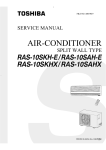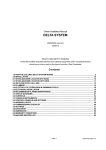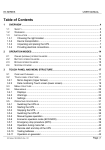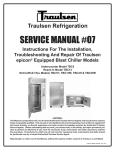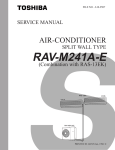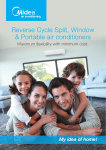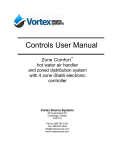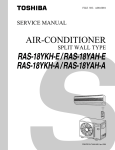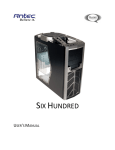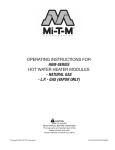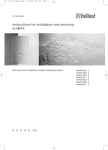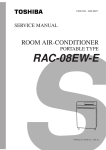Download RAS-07EKH/RAS-07EAH RAS-09EKH/RAS-09EAH
Transcript
FILE NO. A10-9508 SERVICE MANUAL AIR-CONDITIONER SPLIT WALL TYPE RAS-07EKH/RAS-07EAH RAS-09EKH/RAS-09EAH TOSHIBA PRINTED IN JAPAN, Dec., 1995 S CONTENTS 1. SPECIFICATIONS....................................................................................................... 3 ~ 5 2. CONSTRUCTION VIEWS ........................................................................................... 6 ~ 7 2-1. 2-2. Indoor Unit ........................................................................................................................................ 6 Outdoor Unit ...................................................................................................................................... 7 3. CAUTION IN INSTALLATION.................................................................................... 8 ~ 12 3-1. 3-2. 3-3. Installation of Indoor Unit .................................................................................................................. 8 Flaring ............................................................................................................................................. 10 Pipe Process Points ......................................................................................................................... 11 4. WIRING DIAGRAM ......................................................................................................... 13 5. SPECIFICATIONS OF ELECTRICAL PARTS ................................................................. 14 5-1. 5-2. 5-3. RAS-07EKH/RAS-07EAH (Indoor Unit) .......................................................................................... 14 RAS-07EAH (Outdoor Unit) ............................................................................................................ 14 RAS-09EAH (Outdoor Unit) ............................................................................................................ 14 6. REFRIGERANT CYCLE DIAGRAM ............................................................................. 15 7. MICRO-COMPUTER BLOCK DIAGRAM ........................................................................ 16 8. OPERATION DESCRIPTIONS............................................................................... 17 ~ 31 8-1. 8-2. 8-3. 8-4. 8-5. 8-6. 8-7. 8-8. 8-9. 8-10. 8-11. 8-12. 8-13. 8-14. 8-15. 8-16. 8-17. Names and Functions of Indicators and Controls on Indoor Unit .................................................... 17 Functions on Remote Controller ...................................................................................................... 17 Names and Functions of Indicators on Remote Controller .............................................................. 19 Handling the Remote Controller ...................................................................................................... 19 Automatic Operation ....................................................................................................................... 21 Heating/Cooling/Fan Only Operation .............................................................................................. 22 Dry Operation .................................................................................................................................. 23 Timer Operation .............................................................................................................................. 23 ADJUSTING AIR FLOW DIRECTION ............................................................................................. 25 FAN ONLY Operation ...................................................................................................................... 27 COOL Operation ............................................................................................................................. 27 HEAT Operation .............................................................................................................................. 28 ECONO. Mode ................................................................................................................................ 28 DRY Operation ................................................................................................................................ 29 AUTO Operation ............................................................................................................................. 29 Cool Airflow Prevention Control....................................................................................................... 30 Defrost Operation ............................................................................................................................ 31 9. TROUBLESHOOTING CHART ............................................................................... 32 ~ 44 9-1. 9-2. 9-3. 9-5. 9-6. What to be Rechecked First ............................................................................................................ Primary Judgement of Trouble Sources .......................................................................................... Troubleshooting Flowcharts ............................................................................................................ How to Check the Remote Control (Including the Indoor PC Board) ............................................... PC Board Layout ............................................................................................................................. 32 33 37 40 43 10. EXPLODED VIEWS AND PARTS LIST .............................................................. 45 ~ 47 10-1. Indoor Unit ...................................................................................................................................... 45 10-2. Outdoor unit .................................................................................................................................... 47 –2– 1. SPECIFICATIONS Model RAS-07EKH/EAH Item Capacity 220V 1.78 6070 kW *1 Btu/h Phase V Hz W % A Indor/Outdoor Power source Power consumption Power factor Running current Starting current Moisture removal Noise Refrigerant Indoor (H/M/L) Outdoor (220/230/240V) Name of refrigerant Rated volume A lit/h dB dB kg (oz) Refrigerant control Interconnection pipe Condensale drain pipe INDOOR UNIT Dimensions Gas side size Connection type Liquid side size Connection type Maximum length (of one way) Maximum height Indoor unit higher Outdoor unit higher Outer diameter Height Width Depth Net weight Evaporator type Indoor fan type Air volume High fan Medium fan Low fan Fan motor output Air filter OUTDOOR UNIT Dimensions Net weight Condenser type Outdoor fan type Air flow volume Fan motor output Compressor Safety device Auto louver Usable outdoor temperature range Height Width Depth mm (in) mm (in) m (ft) *2 240V 1.82 6210 220V 1.83 6240 Heating 230V 1.85 6310 240V 1.87 6380 Single 220/230/240 50 560/570/580 490/500/510 100/100/99 100/100/100 220V 230V 240V 220V 230V 240V 0.19/2.36 0.20/2.28 0.22/2.22 0.19/2.04 0.20/1.97 0.22/1.91 10 0.8 43/36/31 47/48/49 R22 0.65 (22.9) Capillary tube 9.52 (3/8) Flare connection 6.35 (1/4) Flare connection 10 (32.8) m (ft) m (ft) mm (in) 5 (16.4) 5 (16.4) 16 (5/8) RASmm (in) mm (in) mm (in) kg (lbs) 07EKH 265 (10.4) 790 (31.1) 155 (6.1) 8 (17.6) Finned tube Cross flow fan 462 (274) 370 (215) 300 (175) m3/h (CFM) m3/h (CFM) m3/h (CFM) W RASmm (in) mm (in) mm (in) kg (lbs) m3/h (CFM) W Model Output Cooling 230V 1.80 6140 W °C Polypropylene net filter (Washable) 07EAH 530 (20.9) 770 (30.3) 200 (7.9) 29 (63.9) Finned tube Propeller 1500 (890) 18 PH70T1-4C 500 Fuse, Overload relay Yes 21 – 43 Specifications are subject to change without notice. –3– –10 – 21 Model RAS-09EKH/EAH Item Capacity 220V 2.28 7780 kW *1 Btu/h Phase V Hz W % A Indor/Outdoor Power source Power consumption Power factor Running current Starting current Moisture removal Noise Refrigerant Indoor (H/M/L) Outdoor (220/230/240V) Name of refrigerant Rated volume A lit/h dB dB kg (oz) Refrigerant control Interconnection pipe Condensale drain pipe INDOOR UNIT Dimensions Gas side size Connection type mm (in) Liquid side size Connection type Maximum length (of one way) Maximum height Indoor unit higher Outdoor unit higher Outer diameter mm (in) Height Width Depth Net weight Evaporator type Indoor fan type Air volume High fan Medium fan Low fan Fan motor output Air filter OUTDOOR UNIT Dimensions Net weight Condenser type Outdoor fan type Air flow volume Fan motor output Compressor Safety device Auto louver Usable outdoor temperature range Height Width Depth m (ft) 240V 2.32 7920 220V 2.47 8430 Heating 230V 2.50 8530 240V 2.53 8630 Single 220/230/240 50 740/750/760 670/680/690 95/94/92 94/92/89 220V 230V 240V 220V 230V 240V 0.19/3.34 0.20/3.27 0.22/3.22 0.19/3.05 0.20/3.03 0.22/3.00 14 1.2 43/36/31 47/48/49 R22 0.67 (23.6) Capillary tube 9.52 (3/8) Flare connection 6.35 (1/4) Flare connection 10 (32.8) *2 m (ft) m (ft) mm (in) 5 (16.4) 5 (16.4) 16 (5/8) RASmm (in) mm (in) mm (in) kg (lbs) 09EKH 265 (10.4) 790 (31.1) 155 (6.1) 8 (17.6) Finned tube Cross flow fan 462 (274) 370 (215) 300 (175) m3/h (CFM) m3/h (CFM) m3/h (CFM) W RASmm (in) mm (in) mm (in) kg (lbs) m3/h (CFM) W Model Output Cooling 230V 2.30 7850 W °C Polypropylene net filter (Washable) 09EAH 530 (20.9) 770 (30.3) 200 (7.9) 29 (63.9) Finned tube Propeller 1500 (890) 18 PH94T1-4C 750 Fuse, Overload relay Yes 21 – 43 Specifications are subject to change without notice. –4– –10 – 21 Note: *1 • Capacity is based on the following temperature conditions. JIS C9612-1994 Indoor unit inlet air temperature Outdoor unit inlet air temperature Cooling Heating (DB) 27°C 20°C (WB) 19°C – (DB) 35°C 7°C (WB) 24°C 6°C Note: *2 CHARGELESS • No additional refrigerant required. • This air conditioner accepts a connection piping length of up to 10m and a head of up to 5m. • There is no need to add the refrigerant as long as the total length of the connection piping is up to 10m. –5– 2. CONSTRUCTION VIEWS 2-1. Indoor Unit RAS-07EKH RAS-09EKH Heal exchanger Air filter Air inlet Wireless remote controller 265 136 790 55 16 59.6 5 112.8 Remote controller holder Air outlet Single phase 220-240V (50Hz) 790 222 Front panel Hanger 346 155 222 392 Back body Hanger Drain hose Connecting pipe (0.47m) (0.53m) (Flare ø6.35) Connecting pipe (0.37m) Terminal block (Flare ø9.52) 659 450 For stud bolt 346 (ø8 ~ ø10) For stud bolt (ø6) 40 or more Minimum distance to ceiling 21 3 20 44 Detail of installing dimensions of the main unit Hanger Minimum distance to wall 120 or more 289 Center line Installation plate center line 790 Installation plate outline Fig. 2-1 –6– 106 40 106 2-ø65 Piping hole 30 Minimum distance to wall 40 231 30 265 20 170 or more 2-2. Outdoor Unit RAS-07EAH RAS-09EAH 600 A Detail Drawing A 85 111 36 Gas side (flare ø9.52) ø25 Drain hole 600 50 216 230 216 30 230 R10 25 36 ø11x14 Hole Liquid side (flare ø6.35) 50 ø6 Hole 8-ø6 Holes (For fixing the outdoor unit) 4-ø11x14 Long holes (For anchor bolt ø8-ø10) 111 Handle 5 11 11 Fan guard 200 ø420 TOSHIBA Electric parts cover 525 530 Z 268 54 62 5 89 Access for charging 770 59 Z View Inlet port 600 or more Inlet port 100 or more Visible outline (Minimum distance of the product of the wall) 400 or more 230 45 or more 600 Outlet port 4-ø11x14 Long holes (For anchor bolt ø8-ø10) Center port Mounting dimension of anchor bolt Fig. 2-2 –7– 250 3. CAUTION IN INSTALLATION 3-1. Installation of Indoor Unit 3-1-1. Removing the Front Panel (1) Open the screw caps and remove the two screws securing the front panel. (2) Close the screw caps as behind. (3) Open the air outlet direction (up-down) louver horizontally by hand. (4) Slightly open the lower part of the front panel, then pull the upper part of the front panel toward you to remove it from the rear plate. Open it upward by putting your finger on the edge. (4) (4) Fig. 3-1 Opening the screw cap (1)(2) (3) (1)(2) Air outlet direction louver. Fig. 3-2 Removing the front panel Caution When Connecting the Connecting Cable When connecting the connective cable, follow the instructions below. Note: • (1) Remove the front panel. Rear plate Screws Connect the indoor and outdoor units with a connective cable over the shortest distance as possible. 70mm Rear plate busing Grounding wire 10mm Screw (4) (3) (2) (1) 10mm 50mm Wiring cover Front panel Cord clamp Fig. 3-4 Fig. 3-3 –8– (2) Insert the connective cable fully into the terminal block and secure it by screw tightly. (5) Fix the wiring cover, rear plate bushing and front panel on the indoor unit. (3) Secure the connective cable with the cord clamp. (4) Tightening torque should be 1.2 N.m (12 kgf.cm) Connecting cable 4 Wiring cover 1 2 3 Cord clamp Screws Grounding wire Screw Connecting cable Fig. 3-6 Cord clamp Fig. 3-5 3-1-2. Caution in Mounting the Front Panel When the panel is removed and mounted again, follow the step described below. 3-1-3. Precautions for Refrigerant Piping (1) Under-side connection with piping (1) After fastening two screws, be sure to hook the inside clicks (1) and (2) of the front panel shown in Fig. 3-7, right gap is left between the front panel and the rear plate. Slit part Pipe holder Push Push (1) (2) Rear plate Pipe holder Fig. 3-8 Fig. 3-7 (1) Cut out the knockout piece from the right below of the rear plate with a knife, etc. Smooth the cut edge. Note: • If cooling (dry) operation is made without pushing the air outlet, dew can be attached on the front panel surface. In addition, a gap between the front panel and the body will become wider, spoiling the appearance. (2) Set the drain hose in the inner part of the indoor unit and connecting cable in lower part of it. (3) Wind the tape round them. Indoor unit Piping Connecting cable Wall Drain hose Installation plate –9– Fig. 3-9 3-2. Flaring (2) Left-hand connection with piping When the piping runs to the left, be sure to use a tool such as a pipe bender to bend the pipe. Note: • 3-2-1. Pipe Cutting (1) Cut the pipe little by little advancing the blade of pipe cutter slowly. If the pipe is bent incorrectly, the air conditioner could be raised. 1/4 Thickness Connection pipes Fig. 3-12 Auxiliary pipes Note: Fig. 3-10 (1) When the piping runs to the left, remove the left side body bushing of the rear panel. You may need the body bushing when you relocate the unit, so be sure make the customer keep it in a safe place. • For fine work, do not advance the blade by force in order to prevent distortion of the pipe, and extra burrs. • Cut the pipe a little longer than required. (2) After passing the connection pipe through the pipe hole, connect the connection pipe to the auxiliary pipes and wrap covering tape around them. (3) For left-hand connection with piping, bend the pipes as shown in Fig. 3-11. Connection pipes 120mm 3-2-2. Burr Removal (1) Raise burrs with the burr stick or the burr remover. (Hold the flaring end down to prevent burrs from dropping inside pipe) 43 mm Indoor unit external shape Fig. 3-13 Wall Fig. 3-11 Note: • Bend the connection pipe so that the distance between the pipe and the wall be 43 mm or less. Fig. 3-14 – 10 – Note: • Be sure to remove burrs to avoid unevenness on the flare face which will cause gas leaks. • • Fine flaring work shows even brightness on the flared surface and uniform thickness of pipe. • Unsuccessful flaring work causes gas leaks, therefore rework it. Cover the pipe end with a polyethylene bag and on sheet. Slant Scratch Crack Uneven thickness Fig. 3-17 • The above faulty flaring will cause gas leaks. Fig. 3-15 3-2-3. Point of Flaring (1) The exact length of pipe protruding from the face of the flare die is determined by the flaring, too. 3-2-4. Finishing Work (1) Fix the pipe firmly on the flare die. Match the centers of both the flare die and the flaring punch, and tighten flaring punch fully. D A 3-3. Pipe Process Points 3-3-1. Pipe Bending (1) Carefully bend by hand. Note: Fig. 3-16 • Collapsed pipe cause cooling failure. Note: • Too long a protrusion of pipe from the flaring tool will result in too long a flare; If this happens, the flare nut will not tighten and the joint will not seat. • Too small a protrusion will cause gas leaks. CAUTION: • • Too large protrusion of pipe results in impossible tightening of the flare nut. Fig. 3-18 • Too small a protrusion of pipe will cause gas leaks due to insufficient flare surface. (2) Bend with pipe bender. (Since the insulation is wound on, use the bender by sliding the insulation to one side, or cutting it halfway.) Table 3-1 shows the use of an imperial die and a rigid die. Table 3-1 Type of pipe A (mm) D (mm) Imperial Rigid 1/4” 6.35 1.3 0.7 3/8” 9.52 1.6 1.0 Fig. 3-19 – 11 – (3) The radius of the pipe bend should be 100 mm or more. Note: • Insufficient tightening causes gas leaks. Over tightening results in cracks the flared surface. R 100mm CAUTION: Fig. 3-20 (4) Too small a radius causes collapse of pipe. 10 • Do not use the spanner from the beginning of tightening. • When processing 1/4 inch pipe, tighten lightly with spanner and then tighten additionally by 90 – 120 degree with torque wrench and spanner. 7 Table 3-2 Tightening torque of flare nut Pipe size Standard torque The distortion ratio must be less than 10:7. 6.35 mm (1.4") 9.52 mm (3/8") 15.7 (160) 29.4 (300) (Unit: N.m (kgf.cm)) Fig. 3-21 3-3-2. Pipe Connection (1) Connect the flare pipe close to the air conditioner unit so both faces fit well. Note: • Forcing to tighten the nut without the center axis coincided causes gas leaks. Fig. 3-24 Match centers Flare nut Fig. 3-22 Fig. 3-25 (2) Use a torque wrench and spanner to tighten or untighten the flare nut. Tightening should be done by finger first, then use the torque wrench. A torque wrench helps to provide adequate torque for tightening. Fig. 3-23 – 12 – 4. WIRING DIAGRAM RAS-07EKH/RAS-07EAH RAS-09EKH/RAS-09EAH LOUVER MOTOR 1o 50Hz 220/230/240V~ INDICATION&SWITCH PARTS THERMAL FUSE 77 C (FAN MOTOR) RY08 COMMON GROUND RELAY TERMINAL 3 4 CN12 IC03 3 RY07 POWER 4 RELAY T3.15A 250V R900 TNR C51 IC C60 3 3 BLK 1 1 RED RUNNING CAPACITOR 1 1 CN01 2 2 PTH TH01 IC05 CN29 CN17 1 2 3 1 2 3 4 4 RED WHI BLK 1 1 CN06 1 2 3 1 2 3 1 1 PJ18 1 2 3 1 2 3 GRN &YEL BLU 1 2 3 CN03 RED IC04 GRY ZC BLU ZC 1 1 CN05 3 3 3 CN32 3 INFRARED RAY RECEIVE PARTS 4 TRANSFORMER 3 2 1 CN33 3 2 1 INDOOR OUTDOOR OVER LOAD RELAY 1 2 3 4 GRN&YEL BLK BLK RUNNING CAPACITOR RED RUNNING CAPACITOR COLOR IDENTIFICATION BRW RED WHI YEL BLU BLK GRY PNK ORN GRN&YEL BLK SOLENOID COIL BLK CHASSIS WHI RED BLK COMPRESSOR Fig. 4-1 – 13 – 1 1 2 2 WHI C.T. T01 RED WHI THERMAL PROTECTER (90 C) YEL 1 1 CN13 2 2 GRY 3 3 BRW CN10 WHI 5 5 F01 FUSE BLK WHI RED GRN&YEL GRN &YEL 6 5 4 3 2 1 6 5 4 3 2 1 CN31 1 2 3 1 2 3 1 2 3 4 5 6 7 8 CN24 R901 TNR SG01 DSA P04 FAN MOTOR BLU PNK YEL ORN RED BRW WHI GRY 1 2 3 4 5 6 7 8 CN25 1 2 3 4 5 6 7 8 GRY BRW BLU GRN&YEL : : : : : : : : : : BROWN RED WHITE YELLOW BLUE BLACK GRAY PINK ORANGE GREEN & YELLOW HEAT EXCHANGER SENSOR (TC) THERMO. SENSOR (TA) 5. SPECIFICATIONS OF ELECTRICAL PARTS 5-1. RAS-07EKH, RAS-09EKH (Indoor Unit) No. 1 Fan motor (For indoor) MMF-200-18-2C 2 3 Thermo sensor (TA sensor) Runing for indoor fan motor capacitor Transformer Microcomputer Power relay, Common relay Heat exchanger sensor (TC-sensor) (microporcessor) Specifications Output (Rated) 18W, 2 pole, 1 phase, 220 – 240V, 50 Hz White-Black Winding resistance (Ω) Red-Black (at 20°C) 209.4 101.6 Adjustable range: 17 – 30°C EVN40M105UL1 400WV, 1µF TTZ-200/240-1 TMP87CH40N G4A-1A (microprocessor) Primary 200 – 240V, Secondary 15V 4 5 6 7 Parts name Type Coil: 12V 90mA, Rated 250V 20A 10 KΩ at 25 °C 5-2. RAS-07EAH (Outdoor Unit) Parts name No. 1 Type Compressor PH70T1-4C Fan motor (For outdoor) UE6-21A5P 2 3 4 5 6 Running capacitor (For fan motor) Running capacitor (For compressor) Solenoid coil Overload relay EEP2G155HQA104 SK-40CMF15UT LB60012 J-MRA99259-9201 Specifications Output (Rated) 500W, 2 pole, 1 phase, 220 – 240V, 50 Hz White-Black Winding resistance (Ω) Red-Black (at 20°C) 6.55 4.46 Output (Rated) 18W, 6 pole, 1 phase, 220 – 240V, 50 Hz Red-Black White-Black Winding resistance (Ω) (at 20°C) 366.2 368.5 400V AC, 1.5µF 400VAC, 15µF AC: 200/240V AC: 200/240V 5-3. RAS-09EAH (Outdoor Unit) No. 1 Parts name Type Compressor PH940T1-4C Fan motor (For outdoor) UE6-21A5P 2 3 4 5 6 Running capacitor (For fan motor) Running capacitor (For compressor) Solenoid coil Overload relay EEP2G155HQA104 EAG40M206UF2 LB60012 J-MRA99260-9200 Specifications Output (Rated) 750W, 2 pole, 1 phase, 220 – 240V, 50 Hz White-Black Winding resistance (Ω) Red-Black (at 20°C) 8.73 4.53 Output (Rated) 18W, 6 pole, 1 phase, 220 – 240V, 50 Hz Winding resistance (Ω) Red-Black White-Black (at 20°C) 366.2 368.5 400V AC, 1.5µF 400V AC, 15µF AC: 200/240V AC: 200/240V – 14 – 6. REFRIGERANT CYCLE DIAGRAM RAS-07EKH/RAS-07EAH RAS-09EKH/RAS-09EAH Indoor unit Evaporator TI Cooling 0.37m (Connecting pipe) / 9.52 Heating 0.47m (Connecting pipe) / 6.35 Cross flow fan O.D. : 9.52mm Optional piping kits RB-P31BEF1 (3m) RB-P51BEF1 (5m) RB-P71BEF1 (7m) P O.D.:6.35mm Packed valve ( / 9.52) Cooling PH70T1-4C(RAS-07EAH) (Rated volume 0.65 kg) Heating 4-way valve Heating Cooling Packed valve ( / 6.35) PH94T1-4C(RAS-09EAH) (Rated volume 0.67 kg) Compressor Accumulator Dryer Condenser Capillary tube RAS-07EAH /1.5x1700 RAS-09EAH /1.5x1500 Propeller fan Cooling Heating Outdoor unit Mark( )means check points of Gas Leak Fig. 6-1 Table 6-1 Standard pressure P (kg/cm2G) Cooling Heating 50Hz Model Standard High temperature Low temperature Standard High temperature Low temperature RAS-07EKH 12.6 17.1 ~ 19.9 10.4 6.5 6.2 4.6 RAS-09EKH 14.2 19.8 ~ 22.8 11.9 6.2 6.9 4.5 Surface temp. of heat exchanger interchanging pipe T 1 (°C) RAS-07EKH 34.5 45.5 ~ 52.0 29.5 12.5 18.5 3.0 RAS-09EKH 38.5 52.0 ~ 59.0 34.1 11.4 14.6 2.4 Fan speed (indoor) High Low High High High Low Ambient temp. conditions DB/WB (°C) Indoor 20/– 27/– 20/– 27/19 32/23 21/15 Outdoor 7/6 21/15 –10/–10 35/24 43/26 21/15 Note: • Measure the heat exchanger temperature at the center of U-bend (By means of thermistor thermometer.) During heating overload, the high temperature limit control operation is included. – 15 – Infraed Rays Fig. 7-1 – 16 – 1/ 50Hz AC 220/230/240V ECONO. Transformer Louver Direction Setting Louver AUTO Swing OFF TIMER Setting ON TIMER Setting Fan Speed Selection Thermo Setting Operation Mode Selection AUTO,COOL,DRY,HEAT FAN ONLY Operation (START/STOP) Power Source Compressor Power Relay 4-Way Valve Power Photocoupler Louver Motor Relay Driver Louver Driver Compressor ON/OFF Signal Phase Output Processing (Temperature Processing) Clock Frequency Oscillator Circuit 50Hz input DC5V Timer Motor Revolution Control Initializing Circuit 3-minute Delay at Restart for Compressor Current Sensor Infrared Signal Receiver Louver Control Functions C.P.U. Termo. Sensor Heat Exchanger Sensor Main Unit Control Panel Outdoor Fan Motor Indoor Fan Motor PRE-DEF.Sign Display ECONO Sign Display Timer Display Operation Display 7. MICRO-COMPUTER BLOCK DIAGRAM 8. OPERATION DESCRIPTIONS 8-1. Names and Functions of Indicators and Controls on Indoor Unit 8-1-1. Display Panel The operating conditions are indicated below. PRE.-DEF ECONO. TIMER OPERATION OPERATION lamp (green) TIMER lamp (yellow) ECONO. lamp (green) PRE.-DEF lamp (red) Fig. 8-1 TEMPORARY 8-1-2. Control Panel AUTO Lift the front panel to perform control panel setting. TEST RUN (COOL) (1) Opening the front panel 1) Push the PUSH on both lower corners of the front panel. Fig. 8-2 2) Open the panel. You can lift the panel up to an angle where it will remain fixed. Do not lift the panel any further when it stops with a clicking sound. (2) Closing the front panel 1) Push the PUSH on both lower ends of the front panel. 8-2. Functions on Remote Controller (a) Infrared signal emitter Transmits a signal to the indoor unit. (b) START/STOP button 2) Close the panel firmly. • Push the button to start operation. (A receiving beep is heard.) • Push the button again to stop operation. (A receiving beep is heard.) • If no receiving sound is heard from the indoor unit, push the button twice. (3) If the TEMPORARY switch is set to AUTO 1) The air conditioner operates automatically by selecting the cooling, dry, fan only mode depending on the room temperature. (4) If the TEMPORARY switch is set to COOL 1) The air conditioner operates in the cooling mode (at a low fan speed). (c) Mode select button (MODE) Push this button to select modes. Each time you push the button, a mode is selected in a sequence that goes from AUTO, COOL, DRY, HEAT, FAN ONLY, and back to AUTO. (A receiving beep is heard). Note: • REMOTE CONTROL If the TEMPORARY switch is set to AUTO or COOL, the remote controller is not usable. (d) Temperature button (TEMP.) The set temperature is increased to 30°C. The set temperature is decreased to 17°C. (A receiving beep is heard.) – 17 – (e) Fan speed button (FAN) (a) • Push this button to select fan speed. • When you select AUTO, the fan speed is automatically adjusted according to the room temperature. You can also manually select the desired fan speed from three settings. (A receiving beep is heard.) • Push this button to swing the louver. (A receiving beep is heard.) • (i) (d) START/STOP To adjust the air flow direction by the wireless REMOTE CONTROLLER during the air conditioner operation, push this button. (A receiving beep is heard.) While this button is kept depressed, the receiving tone continuously sounds. (j) (b) ECONO. (e) AUTO SET (f) (g) Push this button to set the OFF timer. MODE TIMER (k) (i) Push this button to reserve timer settings. (A receiving beep is heard.) ON OFF RSV (h) (l) Push this button to cancel on timer and off timer. (A receiving beep is heard.) TOSHIBA Economy button (ECONO.) • Push this button to set the economical operation mode of the air conditioner. (A receiving beep is heard.) Fig. 8-3 – 18 – CNL (j) (k) Cancel button (CNL) • (c) Push this button to set the ON timer. Reserve button (RSV) • FAN (l) On timer button (ON) • HIGH Push this button again to stop louver swinging. (A receiving beep is heard.) (h) Off timer button (OFF) • AUTO LOW MED. TEMP. (g) Set louver button (SET) • FAN AUTO COOL DRY HEAT FANONLY (f) Auto louver button (AUTO) • TEMP. MODE 8-3. Names and Functions of Indicators on Remote Controller 8-4. Handling the Remote Controller (a) Transmission indicator Keep the remote controller where its signals can reach the receiver of the air conditioner (a distance of 7m is allowed.) • 8-4-1. Location of the Remote Controller This transmission indicator lights when remote controller transmits signals to the indoor unit. (b) ON/OFF display • Displayed by pushing the START/STOP button. • Push the START/STOP button again to disappear. 7m (c) MODE display • Displays the current operation mode. (d) TEMP. display • • Fig. 8-5 Displays the temperature setting (17°C to 30°C) 8-4-2. Remote Controller Mounting Fixture When you set the operating mode to FAN ONLY, no temperature setting is displayed. A mounting fixture for the remote controller is supplied with it. (1) Installing the mounting fixture (e) ECONO. display • Displayed by pushing the ECONO. button. • Push the ECONO. button again to disappear. Before you actually install the mounting fixture on a wall or the pillar, check whether the remote control unit signals from the location where you will install the fixture can be received by the indoor unit. (r) FAN speed display • Displays the selected fan speed. AUTO and three fan speed levels “LOW”, “MED”, “HIGH” can be indicated. • Displays AUTO when the operating mode is either AUTO or DRY. (g) TIMER display The time set for timer operation is indicated. Note: • In Fig. 8-4, all displays are indicated for the sake of clarity. During operation, only the relevant displays will be shown on the remote controller. Fig. 8-6 (2) Mounting and removing the remote controller (c) (e) (a) MODE (d) TEMP. AUTO COOL DRY HEAT FANONLY (b) (f) To mount, hold the remote controller parallel to the mounting fixture and push it in fully. To remove, slide the remote controller upwards and out from the mounting fixture. FAN AUTO LOW MED. Hr.ON OFF TIMER HIGH (g) Fig. 8-4 – 19 – Fig. 8-7 8-4-3. Replacing Batteries The remote controller uses two alkaline dry batteries (LR03). (1) Remove the cover of the battery compartment at the back of the remote controller by sliding it out in the direction of the arrow. CAUTIONS: • The air conditioner will not operate if curtains doors or other materials block the signal from the remote controller to the indoor unit. • Prevent any liquid from failing into the remote controller. Remove the used batteries and insert new batteries. (2) Press a coin or the similar object against the unit to reset, and perform resetting. Then, close the rear lid. (Once the cell has been replaced, the controller may malfunction. Perform resetting (ACL) accordingly.) Be careful not to reverse the + position and the - position. Do not expose the remote controller to direct sunlight or heat. • If the infrared signal receiver at the indoor unit is exposed to direct sunlight, the air conditioner may not function properly. Use curtains to prevent the sunlight from falling on the receiver. • If the room using the air conditioner has fluorescent lighting with electronic starters, signals may not be properly received. If you are planning to use such florescent lamps, consult your local dealer. • If other electrical appliances react to the remote control, either move these appliances or consult your local dealer. Press a coin or the similar object. If the display should turn out abnormal, the normal display may be restored. Fig. 8-8 Notes: • When replacing batteries, do not use used batteries or batteries of a different type. Such use may cause the remote controller to malfunction. • If you do not use the remote controller over a long period, remove the batteries. Otherwise, battery leakage may damage the remote controller. • The average battery life during normal use is approximately one year. • Replace the batteries when there is no receiving beep from the indoor unit or if the transmission indication lamp on the remote control unit fails to light. – 20 – OPERATING MODE: Once you select the operating mode, the operating conditions are saved in the unit’s microcomputer memory. MODE TEMP. FAN AUTO Thereafter, the air conditioner will start operating under the same conditions when you simply push the START/STOP button of the remote controller. AUTO TEMP. (2) START/STOP (3) 8-5. Automatic Operation When you set the air conditioner in AUTO mode, it will automatically select cooling, or fan only operation depending on the room temperature. ECONO. FAN AUTO SET 8-5-1. Operation Steps • (1) MODE Start TIMER The OPERATION lamp (green) on the display panel of the indoor unit starts flashing. ON OFF RSV CNL (1) Mode button • Select AUTO. TOSHIBA (2) TEMP. button • Push the TEMP. button. • Normally, set it between 21°C to 28°C. (3) START/STOP button Fig. 8-9 • Push this button to start the air conditioner. • The OPERATION lamp (green) on the display panel of the indoor unit lights. The operating mode is selected in accordance with the room temperature and operation starts after approximately 3 minutes. Note: • If the AUTO mode is uncomfortable, you can select the desired conditions manually. • When you select the AUTO mode, you do not have to set the fan speed. The FAN speed display will show AUTO and the fan speed will be automatically controlled. Stop: START/STOP button • Push this button again to stop the air conditioner. Table 8-1 Room temperature of operation Operating conditions The set temperature +1°C or higher (when hot) Cooling operation Performs the cooling operation at a temperature 1°C higher than the setting. The set temperature –1°C to +1°C Fan only operation Performs the fan only oepration (low speed) while monitoring the room temperature. When the room temperature changes, the air conditioner will select the cooling or heating mode. The set temperature –1°C or lower (when cool) Heating operation Performs the heating operation at a temperature 1°C lower than the setting. – 21 – 8-6. Heating/Cooling/Fan Only Operation 8-6-1. Operation Steps MODE Start COOL • TEMP. FAN AUTO The OPERATION lamp (green) on the display panel of the indoor unit starts flashing. TEMP. (1) Mode button • (2) START/STOP Select HEAT, COOL or FAN ONLY. (4) (2) TEMP. button • Push the TEMP. button. • Cooling 21°C or higher. ECONO. FAN AUTO SET (3) (3) FAN button • Select any of the “AUTO”, “LOW”, “MED” and “HIGH”. TIMER (4) START/STOP button • Push this button again to stop the air conditioner. • The OPERATION lamp (green) on the display panel of the indoor unit lights. The operating mode is selected in accordance with the room temperature and operation starts after approximately 3 minutes. (If you select FAN ONLY mode, the unit will start immediately.) ON OFF RSV CNL TOSHIBA Fig. 8-10 Stop: START/STOP button • (1) MODE Push this button again to stop the air conditioner. Note: • – 22 – The FAN ONLY mode does not control temperature. Therefore, perform only steps (1), (3) and (4) to select this mode. 8-7. Dry Operation 8-8. Timer Operation 8-7-1. Operation Steps 8-8-1. Operation Steps Start The timer-reserved time indicates the time remaining available. The time indicated on the remote controller changes accordingly. • The OPERATION lamp (green) on the display panel of the indoor unit starts flashing. (1) ON or OFF TIMER button (1) Mode button • Select DRY. • Push the ON or OFF TIMER buttons as required. • Each time the button is pressed, the timer setting changes and set time flashes. • The indication changes as follows: 0.5 → 1.0 → 1.5 → 2.0 → 3.0 → ... → 23 → 24 Hr. (2) TEMP. button • Push the TEMP. button. • The fan speed indicator displays AUTO. • The indoor fan speed will be automatically selected low. (4) START/STOP button (2) Reserve button (RSV) • Push this button again to stop the air conditioner. • The OPERATION lamp (green) on the display panel of the indoor unit lights, and operation starts after approximately 3 minutes. • Push this button. Check that the TIMER lamp (yellow) on the display panel of the indoor unit is lit. • Push the button once more and you will be able to confirm the available remaining time in the timer. Stop: START/STOP button • Push this button again to stop the air conditioner. (3) Cancel button (CNL) • MODE TEMP. Push the CNL button to cancel the timer setting. FAN AUTO MODE DRY TEMP. FAN AUTO AUTO LOW MED. TEMP. Hr.ON HIGH (2) TEMP. (3) START/STOP START/STOP ECONO. FAN AUTO SET (2) (3) ECONO. FAN AUTO SET (1) MODE TIMER MODE TIMER ON OFF RSV CNL (1) (3) ON OFF RSV TOSHIBA TOSHIBA Fig. 8-11 Fig. 8-12 – 23 – CNL (2) (2) ON TIMER (Stop ∅ Operation) CAUTION: The ON TIMER feature is useful when you wake up in the morning or when you return home. The air conditioner will automatically start operating at the time set. When you select the timer operation, the remote controller automatically transmits the timer signal to the indoor unit at the specified time. Therefore, keep the remote controller in a location from which it can transmit the signal to the indoor unit properly. Example: To turn on the air conditioner 5 hours later. 1) Continue pushing the “ON” TIMER button until you get “5.0”. Changing 2) Push the RSV button. • Push the ON or OFF TIMER button once. • The indication of set time will start flashing. • Perform steps (1) and (2) to change the setting. Hr. Operation 8-8-2. Example of Timer Setting (1) OFF TIMER (Operation → Stop) Stop The OFF TIMER feature is useful when you go to sleep. The air conditioner will stop automatically at the time set. 5.0 hr. Example: To turn off the air conditioner 7 hours later. Fig. 8-14 1) Continue pushing the “OFF” TIMER button until you get “7.0”. 2) Push the RSV button. Hr. OFF ON TIMER TIMER Stop Operation 7.0 hr Fig. 8-13 – 24 – 8-9. ADJUSTING AIR FLOW DIRECTION (4) During cool and dry operation, change the air flow direction within the range indicated. 8-9-1. Adjustment of Vertical Air Flow Direction (1) When using the wireless auto louver, the air flow direction is automatically set to the desired position of the last time adjusted during operation. When the cooling or dry operation, set the louver in the blue zone. The air flow direction is automatically set to the desired position of the last time adjusted. Louver indicator Fig. 8-15 (2) When you stop operation using the remote controller, the louver is closed. Fig. 8-17 Note: • In the Cool or Dry operation, remember not to continue the downward air flowing for a long time to avoid conceivable dewing on the louver surface and resultant dripping trouble. • It is also possible to adjust the air flow direction by the remote controller even when the wireless auto louver is in use, but once the air conditioner operation was stopped and restarted thereafter, the air flowing direction automatically becomes horizontal. • The air flow cannot be adjusted with the remote controller when the air conditioner is stopped. (Also when the ON TIMER is indicated on the display.) Fig. 8-16 (3) When setting the air flow direction to your preference, hold down the SET LOUVER button of the remote controller and set the air flow in the direction you desire. – 25 – 8-9-2. Adjusting the Horizontal Air Flow Direction Preparation: For the cooling or dry operation, move the vertical air flow louver downward using the SET button on the remote controller. (1) Take hold of the lever on the horizontal air flow grilles and move them to adjust the air flow direction as required. Fig. 8-20 CAUTIONS: Lever • The SET and AUTO buttons will be disabled when the air conditioner is not in operation (including when the ON TIMER is set). • Do not operate the air conditioner for long hours with the air flow direction set downward during the cooling or dry operation. Otherwise, condensation may occur on the surface of the vertical louver and cause dew dripping. • Do not move the vertical louver manually. Always use the SET button. If you move the louver manually, it may malfunction during operation. If the louver malfunctions, stop the air conditioner once, and restart. • When the air conditioner is started immediately after it was stopped, the vertical louver might not move for 10 seconds or so. • The angle of the two vertical louvers may differ when they move downward and upward. Fig. 8-18 (2) You can adjust the air flow at the left, right locations of the grilles. (3) For the cooling or dry operation, return the vertical air flow louver to the original position using the SET button on the remote controller. Fig. 8-19 8-9-3. Adjusting the Automatic Swing Air Flow Direction Perform this function while the air conditioner is in operation. (1) Push the AUTO button on the remote controller. (2) To stop the function, push the AUTO button again. (3) To change the swing direction, push the SET button. – 26 – Table 8-2 Manual setting of FAN SPEED PREPARATION: • • • Indication of FAN SPEED Air volume LOW LOW MED MED HIGH HIGH When the power plug (or cord) is connected to EKH: AC 220/230/240V (50 Hz) outlet, the OPERATION (ON) lamp starts flashing, indicating that power has been turned on (or that power failure occurred). Confirm that the remote control TEMPORARY switch is set to the REMOTE CONTROL position. 8-11. COOL Operation (The remote controller’s MODE button is set to the COOL position) When the remote controller’s START/STOP button is pushed, a receive tone is heard from the main unit and the following operations are carried out. (1) Once the setting is made, the operation mode is memorized in the microcomputer so that the same operation can be effected thereafter simply by pushing the START/STOP button. 8-10. FAN ONLY Operation (The remote controller’s MODE button is set to the FAN ONLY position.) (1) Once the setting is made, the operation mode is memorized in the microcomputer so that the same operation can be effected thereafter simply by pushing the START/STOP button. (2) Relay RY07, RY08 is turned on to energize the outdoor unit, and a cool operation is carried out. The indoor fan motor operates as shown in Fig. 8-22 when FAN SPEED button is set to AUTO. The motor operates with a constant air volume as listed in Table 8-2, when the FAN SPEED button is set to LOW, MED, or HIGH. (Room temp. - Set temp.) (2) When the FAN SPEED button is set to the AUTO position, the indoor fan motor operates as shown in Fig. 8-21. When the FAN SPEED button is set to LOW, MED, or HIGH, the motor operates with a constant air volume as listed in Table 8-2. Power relay RY7 is turned off. (Room temp.) Set temp. 27 HIGH HIGH +4 MED +3 LOW (+) +2 LOW +1 LOW (continuous) 0 RY07 OFF Set temp. HIGT Fig. 8-22 AUTO HIGT 26 MED 25 LOW (+) 24 LOW 23 LOW Fig. 8-21 Auto setting of air volume 8-11-1. Louver control (1) When the SET LOUVER button of the remote controller is pushed during the operation, the louver is automatically set to the desired position. (2) When the SET button is pushed, the louver vertically swings within range of 25°. (3) The louver position is stored in the microcomputer, and at the next operation, the louvers will be set to the position automatically. – 27 – 8-12. HEAT Operation 8-13. ECONO. Mode (The remote control MODE button is set to the Heat position.) (The remote controller’s ECONO. button is pushed and ECONO. display is lit.) (1) Once the setting is made, the operation mode is memorized in the microcomputer so that the same operation can be effected thereafter simply by pushing the START/STOP button. (1) When the ECONO. button is pushed, the indoor unit operates quietly and mildly with controlling airflow. Set temp. 0 (3) The airflow fan will operate in the Low position. (Room temp. - Set temp.) (Room temp. - Set temp.) (2) Relay RY07, RY08 are turned on to energize the outdoor unit, and a heat operation is carried out. The indoor fan motor operates as shown in Fig. 8-23, when FAN SPEED button is set to AUTO. The motor operates with a constant air volume as listed in table 8-2, when the FAN SPEED button is set to LOW, MED, or HIGH. (2) In the ECONO. mode, the indoor unit will operate at set temperature for one hour from starting time, and next 1 hour, operate at temperature adding 1°C to set temperature, and then at temperature adding 2°C to set temperature since 2 ours ago. LOW -1 LOW -2 LOW ( + ) -3 MED ( - ) -4 +2 +1 Set temp. 0H 1H 2H TIME MED Fig. 8-24 Fig. 8-23 (1) When the SET LOUVER button of the remote controller is pushed during the operation, the louver is automatically set to the desired position. (2) When the SET LOUVER button is pushed, the louver vertically swings within range of 25°. (3) The louver position is stored in the microcomputer, and at the next operation, the louvers will be set to the stored position automatically. (4) In the ECONO. mode, the indoor unit will operate at set temperature for one hour from starting time, and next 1 hour, operate at temperature lowering 1°C to set temperature, and then at temperature lowering 2°C to set temperature since 2 ours ago. (5) The airflow fan will operate in the Low position. 0H 1H Set temp. (4) When a temperature setting is changed during the heating operation, or when the room temperature becomes close to the temperature setting, the vertical louver might close once and then open again. 8-12-2. Cool Air Flow Control (1) If the indoor heat-exchanger temperature detected by the indoor heat-exchanger sensor is 20°C or below, the indoor fan stops and if the temperature rises to 32°C or above, the fan is restarted. – 28 – (Room temp. - Set temp.) 8-12-1. Louver Control -1 -2 Fig. 8-25 2H TIME 8-14. DRY Operation Table 8-3 (The remote controller’s MODE button is set to the DRY position.) Relation between room temp. (TA) and set temp. (TS) OFF period a ON period b (1) In this mode, a microprocessor control lowers humidity while maintaining a constant temperature. TA > T S + 2 4 min. 6 min. T S + 2 > T A > TS 5 min. 5 min. TS > TA 6 min. 4 min. (2) The microprocessor turns the compressor on and off at regular intervals (4 to 6 minutes on and/or off). During the compressor off, the airflow fan will operate in the ultra low position. (3) The compressor and airflow fan will operate independent of the temperature control, though the pattern of operation depends on the relation between room temperature (TA) and set temperature (TS), as shown below: b a minutes b Compressor Stop Airflow fan Stop Low Low *U.L. Stop Low U.L. Stop Low U.L. U.L. • The airflow fan will operate in the Low position, independent of the position of the airflow setting control. 8-15. AUTO Operation (The remote controller’s MODE button is set to the AUTO position and AUTO display is lit.) (1) One of the 3 modes, Cooling, Fan only and Heating is selected according to room temperature at which operation is to start, as shown in Fig. 8-27. The Fan mode will continue until room temperature reaches a level at which another mode is selected. 8-15-1. Temporary Auto When the TEMPORARY switch is set to AUTO., the set temperature is fixed at 24°C and controlled in accordance with the chart shown in Fig. 8-27. *Ultra Low Room temperature (T A) measurement timing Time (Room temp. - Set temp.) Fig. 8-26 Cooling mode (The same cooling mode as when the room temperature control is is set at set temp. + 1 C) The Lover moved MID-SUMMER control. Cooling mode (The same cooling mode as when the room temperature control is is set at set temp. + 1 C) Fan only mode (Low position) Cooling mode (The same cooling mode as when the room temperature control is is set at set temp. + 2 C) +4 +1 -1 Fig. 8-27 Note: • Operation is controlled at temperature above, independent on the position of the room temperature control. – 29 – 8-15-2. Current Limit Control and High-temperature Limit Control (during Heating) 8-16. Cool Airflow Prevention Control When the load increases (overload) or the line voltage drops during operation of the air conditioner, the operating current increases, and when the power capacity is exceeded, the circuit breaker is activated. This control is performed automatically when the current (heat exchanger temperature) exceeds a certain value so that it is decreased automatically to prevent overload to the supply. Control is performed as described in (1) and (2). (1) When control is performed with a thermostat, and the thermostat is set to off, the indoor fan stops operating, and restarts at the ultra low speed after 2 minutes and 20 seconds. Set temperature -1 (1) Current limit control' Control is performed as shown below by detecting the compressor operation current with a current sensor. I3 I2 I1 I0 ON OFF ON Indoor fan ON ON(OFF) ON Fig. 8-30 When the value than I2 point continues for 5 minutes the compressor is tuned off. When the value than I3 point continues for 3 seconds (A) the compressor is tuned off. 8.2 6.9 5.8 5.5 Thermostat (2) When the heat operation starts, the indoor fan is kept off until the indoor heat exchanger temperature reaches a set temperature. Outdoor fan operation (Control is performed according to the air volume changeover position.) ( C) Heat exchanger temperature 33 UL Fan ON Compressor Outdoor fan ON OFF ON ON OFF ON 25 UL Fan OFF 20 Fan stop Fig. 8-28 (2) High-temperature limit control Control is performed as shown in Fig. 8-29 by detecting the heat exchanger temperature with a heat exchanger sensor (TC). Fig. 8-31 (3) As soon as the defrost operation starts, the indoor fan stops. ( C) Heat exchanger temperature Compressor Outdoor fan 60 53 52 ON ON OFF OFF ON ON Fig. 8-29 – 30 – 8-17-3. Ending condition at Defrost Operation 8-17. Defrost Operation 8-17-1. Condition to Start the Defrost Operation Defrost operation starts when the elapsed time is longer than 40 to 90 minutes, whichever specified. Note: • When the compressor current becomes 5.5A or more during defrost operation, the defrost operation stops and the heat operation restarts. (The current sensor detects the compressor current.) The defrost operation continues for at most 6 minutes. When the high-temperature limit control operation (with the outdoor fan OFF) is performed for a total of 90 minutes, defrost operation starts and continues for 10 minutes. Indoor hcal excanger temperature (Tc) -indoor intel temperature (TA) (21) C The cumulative operation time is cleared only when the defrost operation is completed. D A B 40 minutes C Cumulative compressor operation time 90 minutes Fig. 8-32 8-17-2. Defrost Operation Time Control (1) The heating operation is performed for at least 40 minutes. (2) The maximum defrost operation time is 6 minutes. The defrost operation time for the 4th cycle is 10 minutes. (When the outdoor temperature is very lower, however, the defrost operation time is 10 minutes.) Max 6 minutes Defrist Heating minutes 40 Defrist Heating minutes 40 Defrist Heating minutes 40 Defrist Heating minutes 40 10 minutes 1 cycle Fig. 8-33 – 31 – DEFROST LAMP: • During defrost operation, the PRE-DEF. lamp is on and the indoor and outdoor fans are off. • The compressor start protection timer is interlocked with the PRE-DEF. lamp. So the PREDEF. lamp is off (the fans stop) for about 3 minutes after the START/STOP button is turned on. When the compressor is turned on, the PRE-DEF. lamp comes on. After the heat exchanger is preheated to about 30°C or higher, the PRE-DEF. lamp goes off, and the indoor fan starts. 9. TROUBLESHOOTING CHART Troubleshooting Procedures: • Following details of “What to be prechecked first”, make sure of the basic items. • When there is no trouble corresponding to above, check in detail the faulty parts following “How to judge faulty parts by symptoms” later. 9-1-3. Misleading but Good Operations (Program Controlled Operation) 9-1. What to be Prechecked First 9-1-1. Power Supply Voltage The line voltage must be AC 220/230/240V. If the line voltage is not within this range, this air conditioner may not work normally. 9-1-2. Incorrect Cable Connection between Indoor and Outdoor Units. The microcomputer performs the operations listed in Table 9-1 to control the air conditioner. If a claim is made on the operation, check whether it corresponds to the contents in the Table 9-1. If it does, it is an indispensable operation for the control and maintenance of the air-conditioner: it is not a failure of the unit. The indoor unit is connected to the outdoor unit with 5 cables. Make certain that the indoor and outdoor units have been connected properly, with terminals assigned the same numbers wired to each other. If the connectors are not connected as specified, the outdoor unit will not operate normally. It should be noted that if terminals 1 and 3 or terminals 1 and 4 are connected together by mistake, some copper foil patterns on the control section PC board may be broken. • Misleading but good operations Table 9-1 Description Operation of air-conditioner When the POWER plug socket of the indoor unit is inserted, the OPERATION lamp on the setting indication part flashes. The OPERATION lamp flashes, indicating that power is turned on. If this happens, press the START/STOP button once to cause the lamp to stop flashing. A power outage also causes the lamp to flash. Fan speed remains unchanged in teh dry mode. Fan speed is fixed at Low in the dry mode. Room temperature is in the range under which the compressor is turned off, but the compressor will not stop. The compressor will not stop while the compressor onhold timer (two-minute timer) is actuated. The compressor will not switch on or off even when the thermo control is operated in the dry operation. In the dry mode, the compressor goes on and off at regular intervals, independent of the Thermo control. The PRE.-DEF. lamp comes on when the heating operation is started. The PRE.-DEF. lamp comes on during defrost operation and when the indoor heat exchanger temperature is low when the heating operation is started. At this time, the indoor fan is stopped to prevent cold air from drifting into the room. The outdoor fan stops once in a while during the heating operation. • Whent eh indoor heat exchanger temperature is high, the outdoor fan may be stopped by teh high-temprature limit control operation. • When the compressor current is large, the outdoor fan may be stopped by teh current control operation. – 32 – 9-2. Primary Judgement of Trouble Sources 9-2-1. Role of Indoor Unit Controller 9-2-2. Display of Abnormalities and Judgement of the Abnormal Spots The indoor unit controller receives the operation commands from the remote control and assumes the following functions. • Measurement of the draft air temperature of the indoor heat exchanger by using the thermo. sensor (TA) • Louver motor control • Control of the indoor fan motor operation • Control of the LED display • Control of the outdoor unit compressor and the outdoor fan motor. The indoor unit of this machine observes the operation condition of the air conditioner and displays the contents of the self-diagnosis as block displays on the display panel of the indoor unit. Table 9-2 Check code Block display OPERATION display flashing (1 Hz) – Check code Self-diagnosis Power failure (When power is on) OPERATION display flashing (5 Hz) Thermo sensor (TA) short/break OPERATION display flashing (5 Hz) Heat exchanger sensor (TC) short/break OPERATION display flashing (5 Hz) Indoor fan lock, abnormality of indoor fan, IC03, D15 short/break OPERATION display flashing (5 Hz) Indoor PC board failure OPERATION and TIMER display flashing (5 Hz) Thermal fuse is blown. (Indoor fan motor is overheat.) OPERATION, TIMER and PRE.-DEF display flashing (5 Hz) • Gas shortage, other refrigerant cycle trouble – • Heat exchanger sensor operan/short • Overload relay trouble • Compressor trouble OPERATION, TIMER and PRE.-DEF display flashing (1) Judgement from defective operation or abnormal operation Table 9-3 Check System No reaction on remote control operation The outdoor fan does not rotate Turn off the power once, turn it on again and try to operate the remote control again. Primary judgement Remote control is not possible. The indoor part (including the remote control) is defective. Remote control is possible. O.K. The compressor operates. The outdoor part is defective (outdoor fan motor) The compressor does not operate. The inside part is defective. – 33 – (2) Self-diagnosis with remote controller 2) Selecting ordinary mode With the indoor unit controller, self-diagnosis of protective circuit action can be done by turning the remote controller operation into service mode, operating the remote controller, observing the remote controller indicators and checking whether OPERATION lamp flashes (5 Hz). Note: • To perform this self-diagnosis, the remote controller with the service code of 43069666 is required. <How to select remote controller operation mode> 1) Selecting service mode Push the switch button provided on rear bottom of the wireless remote control with a tip of pencil for more than 3 seconds. Make sure the setting temperature “ ” is displayed on the display and other display is turned off. Push the all clear button (ACL) on the rear bottom of the wireless remote control with a tip of pencil for more than 3 seconds. Make sure the operation mode display, wind volume display, clock display and setting temperature display are turned on and “ : ” of the clock display is blinking. <Cautions when doing service> 1) After completion of servicing, always push the all clear (ACL) button to return the operation mode to the normal mode. 2) After completion of servicing by the check code, turn off the power once and then turn on the power to reset memorized contents of the microcomputer to the initial status. All clear button Switch for selecting service mode ACL CLOCK ACL CLOCK Rear bottom cover (Rear bottom of remote controller) Fig. 9-1 – 34 – <Self-diagnosis by check codes> 2) Remote control key operation under the service mode is conducted by ON/OFF or TEMP. 1) The self-diagnosis by the check codes is conducted under the block displays of item B-E. The remote control display by each key operation is varied as shown below. Two digit number is displayed in a hexadecimal number. Table 9-4 Indication after operation ,, 1 is added to data before operation. (Example) TEMP. (Down) 1 is subtracted from data before operation. (Example) ,, “AUTO” LOUVER 10 is subtracted from data before operation. (Example) ,, “SET” LOUVER Data before operation is directly transferred. (Example) ,, ,, ,, ,, ,, 3) The self-diagnosis by the check codes is conducted with procedures shown below. a) Enter the service mode and make sure the off timer display of the remote control shows “ ”. b) Operate the “ON/OFF” key and make sure the timer lamp on the display section is flashing (5 Hz). c) At the same time, also make sure the operation lamp is also flashing. This shows that the protection circuit on the indoor PC board is working. – 35 – ,, ,, (Up) ,, ,, TEMP. ,, ON/OFF ,, Operating key ,, ,, ,, ,, d) Operate the TEMP. key and make sure the remote control display shows “ ” and flashing of the operation lamp. If the operation lamp is flashing, it shows the protection circuits for connecting cable is working or thermal fuse is blown. e) In the same way, operate the TEMP. key so that the display is increased one by one to continue checks by the self-diagnosis as shown is the next table. From “ ” up to “ ” check operations of protection circuits for each block, and “ ” to “ ” check operations of the typical protection circuits. Table 9-5 Block level Check code Block Indoor PC board Cable connection/ Thermal fuse Refrigerant system Diagnosis function Check code Symptom Air conditioner status Judgement and action Condition Thermo sensor short/break. Continued operation Indicated when detected abnormal. • Check thermo sensor. Heat exchanger sensor short/ break. Continued operation Indicated when detected abnormal. • Check heat exchanger sensor. Indoor fan lock, abnormality of indoor fan. All off. Indicated when detected abnormal. • Check motor. Abnormality of other indoor unit PC board. Continued operation Indicated when detected abnormal. Replace PC board. • Thermal fuse cut off. All off. Indicated when detected abnormal. • Check thermal fuse. • Indoor fan lock, abnormality of indoor fan. • Gas shortage. (gas leak) • If it is OK, check PC board. (Around sensor circuit) • If it is OK, check PC board. (Around sensor circuit) • Replace PC board, if the same failure occurs, after the motor check. • If it is OK, check motor. • If motor is OK, check PC board. (12V power circuit) All off. • Other refrigerant cycle trouble. Indicated when detected abnormal. • Check gas quantity. (Check gas leakage) • If it is OK, check heat exchanger sensor. • If heat exchanger sensor is OK, check overload relay. • Heat exchanger sensor off/ break/short. • If overload relay is OK, check refrigerant cycle. • Overload relay break • If refrigerant cycle is OK, check PC board. – 36 – 9-3. Troubleshooting Flowcharts 9-3-1. Power cannot be Turned on (No Operation at All) <Preliminary checks> (1) Is the supply voltage normal? (2) Is the connection to the AC output O.K.? (3) Are the connection of the primary side and the secondary side of the power transformer inserted into the PC board? Turn the power off for about 5 seconds and then turn it on again. Operations Check items NO Probable main causes Does the OPERATION lamp flash? NO Is the termal fuse set on? Remedies Replace. Thermal fuse is defective. Item by symptoms YES Does operation start when you press the START/STOP button of the remote control ? NO Does the transmission indicator of the remote control blink normally, and is the transmission really performed? YES NO Remote control is defective. Replace. YES (Normal) NO Is the voltage display on the rear panel of the PC board normal? (12V DC or 5V DC) YES Is 50Hz 220/230/240V AC supplied to the primary side of the power source transformer? YES Refer to the below. NO Is 12V AC supplied to the secondary side of the power transformer? YES Refer to above "Preliminary checks". Or there is a defect before the power transformer. NO Power transformer is defective. Replace power transformer or the PC board. Microcomputer is defective. Replace the PC board. Refer to the figure below. Primary side Color identification WHI : WHITE RED : RED YEL : YELLOW BLU : BLUE Secondary side CN32 CN33 Transformer PC board (MCC-629) CN06 CN05 Main PC board (MCC-639) Fig. 9-2 Power transformer connection diagram – 37 – 9-3-2. Relay RY07, RY08 do not Operate. Louver is not controlled automatically. Turn the power ON. NO Does the OPERATION lamp flash? See "Power cannot be turned on". YES Relay driver IC02 or C.P.U. IC01 is defective. Replace PC board. Note: • When wiring to the thermal fuse has been broken, the timer lamp and operation lamp will flash with 5 Hz. 9-3-3. Only the Indoor Fan does not Operate. <Preliminary checks> Does it neither work in COOL or FAN ONLY operation? < Check procedure > Turn the power ON. NO Does the OPERATION lamp flash? See "Power cannot be turned on". YES Is the photocoupler IC03 normal? Point for placing the tester bar Polarity : + Polarity : - +5V Pin 3 of IC04 NO Microcomputer is defective. NO PC board is defective. Replace PC board. MF capacitor is defective. Replace MF capacitor. Fan motor is defective. Replace. Normal voltage value On fan operation: 0.5V DC YES Is any voltage supplied to the fan motor? Point for placing the tester bar CN13 terminal No. CN13 terminal No. 1 3 YES Normal voltage value. On fan operation: 120V AC Check after the fan motor has been connected. – 38 – 9-3-4. Compressor does not operate. (Indoor fan also does not turn.) < Preliminary checks > (1) Is the temperature set on the remote control higher than the room temperature in cool operation? (2) Is contact of the crossing wiring O.K.? < Check procedure > Turn the power ON. NO Does the operation lamp flash? Refer to "Power cannot be turned on". YES NO Does power relay RY07 switch due to temperatue adjustment? Point for placing the tester bar Polarity : + Polarity : - Condition Is the resistance value of the thermo sensor (TA) and heat exchanger sensor (TC) normal? Normal voltage value Pin 6 of RY07 Pin 5 of RY07 RY07 ON DC 12V NO Approximate resistance value of the sensor YES Normal voltage value under power relay ON condition. 10 C 20 C 30 C 20.7k W 12.6k W 7.97k W YES Thermo sensor or heat exchanger sensor is defective. Is 220/ 230/ 240V AC supplied between pins 1 and 2 of terminal block ? NO Replace TA sensor or TC sensor YES Outdoor unit is defective. – 39 – Microcomputer is defective. Replace PC board. Power relay RY07 is defective. Replace power relay. 9-5. How to Check the Remote Control (Including the Indoor PC Board) Push the START/STOP F button There is no reception tone from the receptor. The operation lamp of the air conditioner main unit does not light. NO Does the transmission indicator flash? YES Is there direct sunlight on the receptor of the air conditioner? NO NO Is operation possible when the transmitter is moved nearer to the infrared signal receiver of the air conditioner? YES Short-circuit the metal terminal at the side of the bettery compartment (all-clear terminal) with a pencil. (wait about 10 seconds). YES Is there any thyristor fluorescent light near by? NO Does the transmission indicator light? YES YES Battery life Is operation possible when setting the control operation switch of the air conditioner main unit to "COOL" or "AUTO"? NO NO NO YES Is there any reception tone and operation? YES Can any signal tone be heard in a transistor radio when transmitting within 5cm distance from the radio? NO YES Avoid direct sunlight. Keep the air conditioner away from thyrstor fluorescent light. PC board is failure. Replace the batteries. Note: Replace PC board. – 40 – Normal After battery replacement, shortcircuit the metal terminal at the side of the battery compartment (all-clear terminal) with a pencil. Remote control is failure. Replace remote control. 9-5-1. How to check the PC board (1) Operating precautions 2) The PC board consists of the following 4 parts: a. Main PC board part: 1) When removing the front panel or the PC board, be sure to disconnect the power plug from the AC outlet. Power relay, indoor fan motor drive circuit and control circuit, C.P.U. and peripheral circuits, buzzer drive circuit and buzzer. 2) When removing the PC board, hold the edge of the PC board and do not apply force to the parts. b. Light receiving unit: Light receiving circuit c. Display: 3) When connecting or disconnecting the connectors on the PC board, hold the whole housing. Do not pull at the lead wire. (2) Inspection procedures 1) When a PC board is judged to be defective, check for disconnection, burning, or discoloration of the copper foil pattern or this PC board. LED d. Switch PC board: Wireless-control, temporary switch Check the defects of the PC board following the list below. (3) Checking procedure Table 9-7 Procedure • Disconnect the power plug from the AC outlet and remove the PC board assembly from the electronic parts base. Check point (Symptom) Is the fuse blown? Trouble cause • Application of shock voltage • Short-circuit of the indoor fan motor • Remove the flat cable from the terminal plate. • Turn the power ON. Check power supply voltage. • If the operation lamp flash (0.5 sec. ON, 0.5 sec. OFF), steps 1 – 3 in the right column are not necessary. 1.Between pins 1 and 3 of CN01 (220/230/240V AC) • Defective power cord, power switch, fuse or line filter, or wrong wiring 2.Between pins 1 and 3 of CN02 (12V AC) • Defective power transformer 3.Between Q01 emitter and GND (5V DC) • Defective power circuit or shortcircuited load 4.Between Q03 emitter and GND (12V DC) • Defective power circuit or shortcircuited load 5.Between pin 1 and GND of CN11 (12V DC) • Thermal fuse operation Push the START/STOP button once to set in operation mode. (Do not set to the fan only or on-timer mode.) Start operation by using the anti-restart timer. Check power supply voltage. 1.Power relay coil voltage (12V DC) (pins 5 and 6 of RY7) • Relay coil cable is broken, relay driver (IC181) is defective. 2.Between pins 1 and 2 of PF terminals • Relay contact is defective, PF terminal is defective. • All LEDs of the operation lamp, the timer lamp and the FAN ONLY lamp light up. Display is defective or defect in the 4P housing assembly. • After 3 seconds, normal display does not appear. – 41 – Procedure Check point (Symptom) Push the START/STOP button once to set in operation mode. Trouble cause 1. The compressor does not operate. • The temperature of the Indoor heat exchange unit is extremely low. 2. The operation lamp flashes. • Defective control PC board. Connect the motor connector to “MOTOR” and turn the power ON. Start operation as follows: 1. There is a voltage of 120V or more between the red and black motor connector leads. • Indoor fan motor is defective. 1.Set the operation mode to “FAN ONLY”. 2. The motor does not rotate. (But the key operation of the remote control is accepted.) • Contact of the motor connector is defective. 3. Motor rotates but vibrates hard. • Main PC board is defective. 1.Setting the anti-resistor timer 2.Cooling operation 3.Fan speed: AUTO 4.Set the temperature sufficiently lower than the room temperature. 5.Continuous operation 2.Set the fan speed to “HIGH”. 3.Continuous operation Table 9-8 Approximate value of the sensor (thermistor) resistance (TA, TC) Sensor Temperature Thermo Sensor (= kΩ) 0°C 10°C 20°C 25°C 30°C 35.8 20.7 12.6 10.0 7.92 9-5-2. How to Reduce the Operation Time of the Anti-restart Timer • Drill 2 holes on the rear of the wireless remote control unit. Wireless remote controller Attach the diode (1S1555 or equivalent) to the rivet inside the unit. • Push the START/STOP button to start operation with the diode attached. Timer short diode Fig. 9-3 – 42 – 9-6. PC Board Layout Top view – 43 – Bottom view – 44 – 10. EXPLODED VIEWS AND PARTS LIST 10-1. Indoor Unit 204 202 226 206 229 208 214 207 217 219 203 218 224 216 209 211 201 233 205 223 221 228 213 232 210 215 227 222 225 220 212 230 231 234 Location No. Part No. 201 202 203 204 205 206 207 208 209 210 211 212 213 214 215 216 217 43005210 43003218 43007963 43007967 43011503 43007964 43019836 43020244 43021990 43007842 43039250 43086989 43006216 43022321 43007098 43007843 43044559 Description Front Panel (EKH) Rear Plate Bush, Rear Plate, Right Lid, Rear Plate Pipe Sealed Bush, Rear Plate, Left Holder Pipe Fan, Cross Flow Fan Motor, AFP-200-18-2B Latch Motor Band Left Owner’s Manual (EKH) Cover, E-Parts (EK) Bearing Cap Screw Bushing Evaporator – 45 – Location No. Part No. 218 219 220 221 222 223 224 225 226 227 228 229 230 231 232 233 234 43047331 43047332 43069858 43021794 43070090 43070140 43009450 43080359 43082271 43063278 43009498 43039251 43080358 43011499 43008691 43019822 43080349 Description Pipe, Delivery Pipe, Suction Remote Controller Motor, Louver Hose, 3M, Drain Hose, Drain Drain Pan and Grill Air-Filter, Left Plate, Inst, Assembly Holder, Remote Controller Grille Base Bearing Air-Filter, Right Pipe Sealed Terminal Cover Holder, Sensor Frame Filter 415 414 402 413 411 412 408 401 409 424 403 405 407 410 406 404 416 421 420 419 423 418 425 426 422 Location No. Part No. 401 402 403 404 405 406 407 408 409 410 411 412 413 414 43063286 43061195 43068418 43068419 43068011 43069573 43060794 43097195 43069627 43060023 43082263 43060007 43068355 43060025 Description Holder-P.C. Board Base, E-Parts P.C. Board Assembly P.C. Board Assembly Switch Sensor, Heat Exchanger Receiver, Infrared Rays Terminal-Block Tamper-Proof-Screw SS-Sensor, Thermostat Cord, Power Screw-Driver Thermal Fuse Set P.C. Board Assembly, Trans Lead Assembly (Transformer Primary) 417 Location No. Part No. 415 43060026 416 417 418 419 420 421 422 423 424 425 426 – 46 – Description Lead Assembly (Transformer Secondary) 43033182 Capacitor, Electrolytic 43054399 Relay Power 43055412 Capacitor, 1.0MFD, 400V 43033211 Capacitor, Film 43033213 Capacitor, ECQ-UV, 0.1MFD, 250V 43055284 Toshiba Non Linear Resistor 43032488 Posistor, 820HM 43060013 Fuse, Time Delay 43060778 Terminal-Block 43060548 Nylon Tie 43058193 CT, Current-Trans 10-2. Outdoor unit 16 23 24 6 17 25 9 5 12 15 13 19 3 19 8 9 10 11 2 20 21 22 18 7 : CAPILLARY TUBE 1 Location No. Part No. 1 2 3 4 5 6 7 8 9 10 11 12 13 14 15 16 43019769 43020223 43005037 43043548 43062194 43005038 43047491 43046229 43047401 43046228 43147196 43046248 43021928 43047549 43046255 43019727 Description Guard, Fan Fan, Propeller Front Cabinet Condenser Cover, E-Parts Back Cabinet Capillary Tube 1.5DIA Packed Valve, 3/8 Bonnet, 3/8 Packed Valve, 6.35 Bonnet, 6.35DIA 4 Way-Valve, VH7100D Fan-Motor, UE6-21A5P Flange, Nut Solenoid Coil Handle – 47 – Location No. Part No. 17 18 19 20 21 43049643 43032441 43019770 43069988 43054400 21 43054401 22 43041142 22 43041564 23 43055470 24 25 43055409 43060049 Description Rubber-Cushion Nipple, Drain Stopper, Guard Holder, OL-Relay Relay, Overload (RAS-07EAH) Relay, Overload (RAS-09EAH) Compressor, PH70T1-4C (RAS-07EAH) Compressor, PH94T1-4C (RAS-09EAH) Capacitor, Plastic Film, 15MFD, 400V Capacitor, 1.5MHD, 400V Terminal Block, 5P TOSHIBA CORPORATION 1–1, SHIBAURA 1– CHOME, MINATO – KU, TOKYO 105 – 01, JAPAN

















































